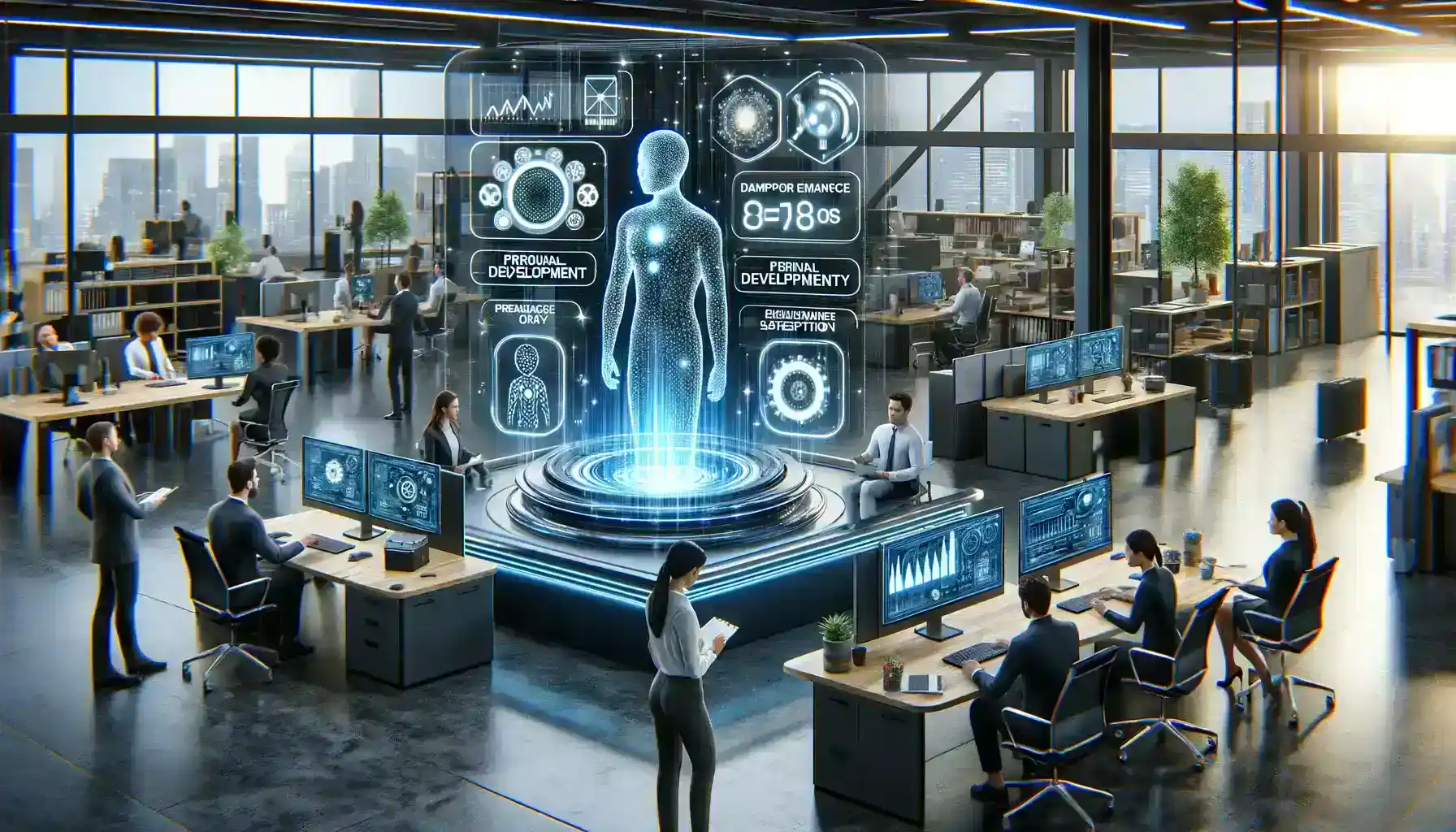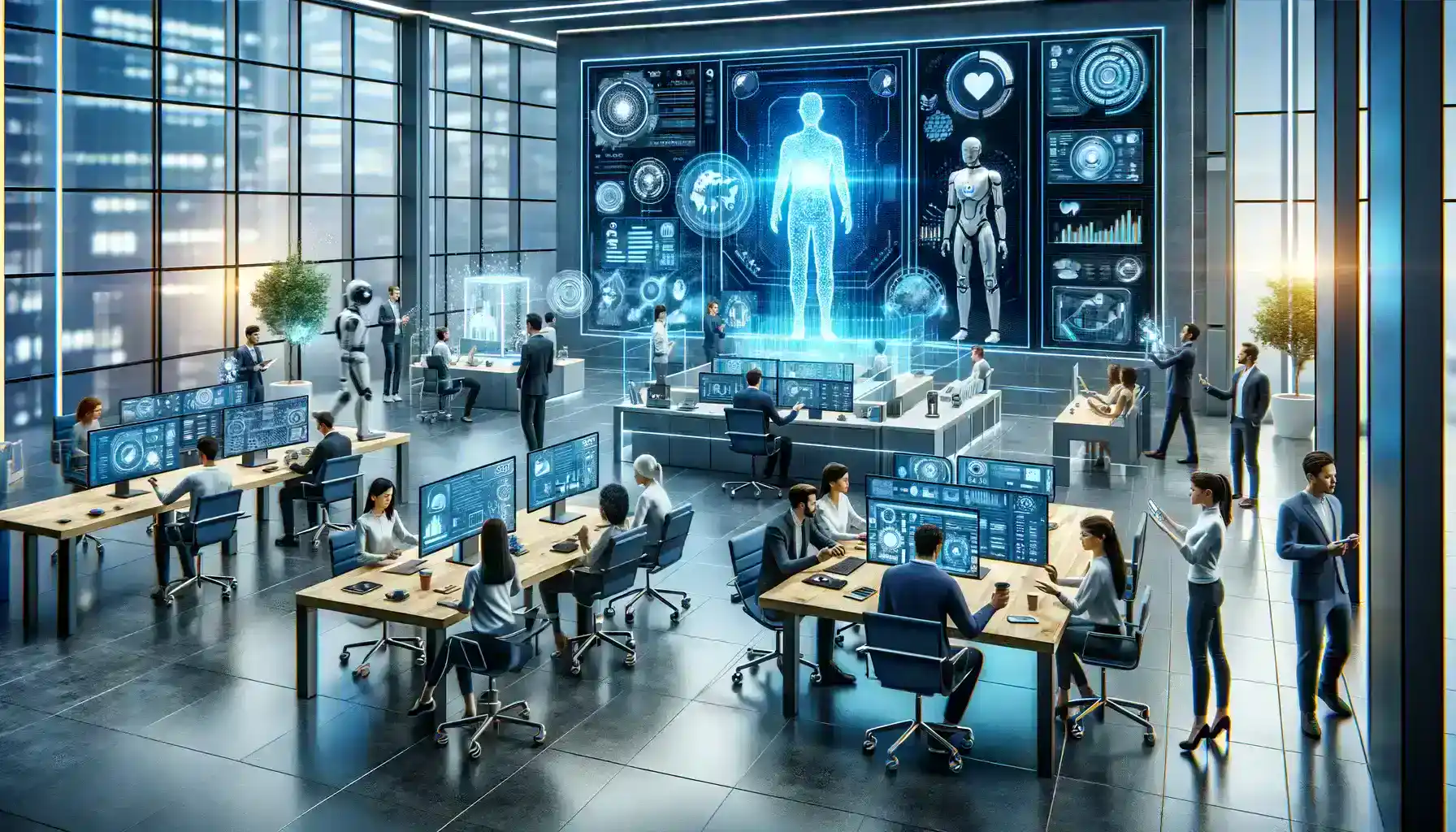Table of Contents
The contemporary workplace is undergoing a revolutionary shift, spurred by the seamless integration of cutting-edge technologies, with Artificial Intelligence (AI) emerging as a pivotal force. This transformation transcends boundaries, deepening the essential domain of employee performance evaluation.
Within this context, this article meticulously explores the multifaceted ways in which AI is orchestrating a paradigm shift, challenging and reshaping conventional approaches to assessing employee performance.
As AI becomes an integral part of organizational processes, its profound impact is not only evident in enhancing objectivity but also in fostering a more dynamic, responsive, and forward-looking approach to workforce evaluation
1. Data-driven Employee Performance Insights
One of the primary ways AI is revolutionizing employee performance evaluation is through its ability to generate data-driven insights. Traditional performance assessments often rely on subjective observations and periodic evaluations, which can be prone to biases and may overlook important nuances in an employee’s contributions. In contrast, AI systems can analyze vast amounts of data from diverse sources, providing a comprehensive and nuanced understanding of an employee’s performance.
AI algorithms can process historical data, project outcomes, collaboration patterns, and individual achievements, extracting valuable insights that transcend surface-level observations. By employing sophisticated data analytics, AI contributes to more objective and evidence-based employee performance evaluations. This data-driven approach not only enhances the accuracy of assessments but also provides organizations with a deeper understanding of the factors influencing employee performance.
The breadth of data analyzed by AI systems encompasses not only individual performance metrics but also broader organizational dynamics. Patterns in collaboration, team interactions, and project outcomes provide valuable insights into the overall health and effectiveness of teams. This holistic understanding allows organizations to identify areas for improvement in team dynamics, communication channels, and collaboration structures. Implementing an employee text alert system can further enhance communication channels within teams, facilitating a quicker response time and smoother collaboration processes.

Additionally, the data-driven insights generated by AI play a pivotal role in aligning individual goals with organizational objectives. By leveraging historical data on goal achievements and project outcomes, organizations can ensure that employee performance aligns with broader strategic goals. This alignment contributes to a more cohesive and purpose-driven workforce, where every employee’s efforts contribute meaningfully to the organization’s overarching mission.
Moreover, AI’s ability to analyze data in real-time allows organizations to keep pace with the dynamic nature of modern work environments. This real-time analysis ensures that employee performance assessments are not based solely on historical data but also consider the most recent contributions and achievements of employees, leading to more relevant and timely feedback.
2. Continuous Feedback Mechanisms
Traditional performance evaluations often suffer from the limitation of being periodic, typically conducted on an annual or semi-annual basis. This periodicity can result in delayed feedback, hindering employees’ ability to make timely adjustments to their performance. AI-driven systems, however, introduce continuous feedback mechanisms that transform the way employees receive insights into their performance.
Real-time feedback allows employees to understand their strengths and areas for improvement promptly. This immediate responsiveness fosters a culture of ongoing improvement, as employees can make necessary adjustments in a timely manner. Continuous feedback not only benefits individual employees but contributes to the overall responsiveness of the workforce.
The transition from periodic evaluations to continuous feedback is a fundamental shift that aligns with the demands of the modern workforce. In an era where agility and adaptability are paramount, waiting for an annual review to address performance issues can be detrimental. AI-driven continuous feedback mechanisms enable a more agile and responsive work environment, where adjustments and improvements can be made in real-time.

Moreover, the immediacy of continuous feedback contributes to a heightened sense of employee engagement. When employees receive timely insights into their performance, it fosters a sense of recognition and acknowledgment. This recognition, coupled with constructive feedback, serves as a motivational catalyst, propelling employees toward higher levels of productivity and commitment.
By fostering a culture of continuous improvement, organizations can adapt swiftly to changing circumstances and market demands. Employees become more agile in their roles, addressing challenges and leveraging opportunities in real-time. This agility is a significant asset in today’s fast-paced business environment, where the ability to respond promptly to evolving situations is a key determinant of success. Continuous feedback, facilitated by AI, not only empowers employees to enhance their performance but also positions organizations to thrive in the dynamic landscape of modern business.
Workday People Analytics: Workday’s People Analytics utilizes AI to analyze employee data, identify performance trends, predict turnover risks, and offering actionable insights for HR teams.
3. Bias Mitigation through Objective Criteria
Bias in performance evaluations has long been a concern in the workplace. Unconscious biases can influence subjective assessments, leading to disparities in how different individuals are evaluated. AI, when designed and trained thoughtfully, offers a robust solution to mitigate biases in performance metrics.
Traditional evaluations often struggle to eliminate biases, as human evaluators may inadvertently bring their subjective perspectives into the assessment process. AI models, on the other hand, are designed to focus on objective criteria and predefined metrics, significantly reducing the impact of unconscious biases.
By relying on measurable factors such as achievements, skills, and contributions, AI ensures that performance assessments are based on consistent and fair criteria. This not only contributes to a more equitable workplace but also enhances diversity and inclusivity. Organizations can create a meritocratic environment where employees are evaluated based on their actual contributions rather than subjective perceptions.
Moreover, the use of AI in bias mitigation aligns with organizations’ commitment to creating diverse and inclusive workplaces. By reducing biases in performance evaluations, AI contributes to fostering an environment where every employee, regardless of background or demographics, has an equal opportunity to succeed and advance in their career.
Textio: Textio analyzes and suggests improvements for performance review language, helping organizations eliminate biased language and ensure more objective and fair evaluations.
4. Predictive Analytics for Future Performance
AI’s predictive analytics capabilities are reshaping how organizations approach employee performance evaluations. Rather than focusing solely on past achievements, AI systems can analyze historical data and performance trends to provide insights into an employee’s future potential and areas for development.
The predictive nature of AI allows organizations to move beyond retrospective evaluations and adopt a more forward-looking approach to performance management. By identifying patterns in employee performance of the past, AI can predict future success and areas where additional support may be needed. This forward-looking approach enables organizations to proactively invest in talent development, ensuring employees are well-prepared for evolving roles and responsibilities.
Predictive analytics in performance evaluation is particularly valuable in talent management and succession planning. Organizations can identify high-potential employees, assess their readiness for leadership roles, and implement targeted development plans to groom future leaders. This strategic use of AI contributes to a more agile and prepared workforce, ready to navigate the challenges of the future.
Furthermore, predictive analytics helps organizations optimize their resource allocation by identifying areas where additional training or support may be required. This targeted approach to talent development ensures that organizations invest their resources wisely, maximizing the impact of their development initiatives.
Reflektive: Reflektive employs AI-driven performance management, offering features like real-time feedback, goal tracking, and analytics to provide a comprehensive view of employee performance.

5. Personalized Development Plans
AI is revolutionizing employee performance evaluation by offering personalized development plans. Traditional approaches often provide generic feedback and development suggestions that may not resonate with individual employees. AI, with its ability to analyze individual strengths, weaknesses, and learning preferences, can recommend targeted training programs, mentorship opportunities, and skill-building initiatives tailored to each employee’s unique profile.
Personalized development plans go beyond one-size-fits-all approaches, acknowledging that each employee has distinct needs and aspirations. AI-driven systems can assess an employee performance, identify areas for improvement, and recommend specific interventions to enhance their skills and competencies.
This level of personalization fosters a sense of individualized growth among employees. When employees perceive that their development plans are tailored to their unique strengths and areas for improvement, they are more likely to engage actively in their own professional development. This, in turn, contributes to higher levels of job satisfaction, increased motivation, and a sense of ownership over one’s career trajectory.
Moreover, personalized development plans contribute to employee retention by demonstrating a commitment to the individual growth and career progression of each employee. In a competitive job market, organizations that prioritize and invest in the professional development of their employees are more likely to attract and retain top talent.
Conclusion
In conclusion, Artificial Intelligence is revolutionizing employee performance evaluation in five key areas: data-driven performance insights, continuous feedback mechanisms, bias mitigation through objective criteria, predictive analytics for future performance, and personalized development plans. The integration of AI in performance evaluation is not a replacement for human judgment but rather a powerful tool that complements and enhances the capabilities of human evaluators.
As organizations continue to embrace the benefits of AI in performance evaluation, they are not only enhancing objectivity and accuracy but also fostering a culture of continuous improvement and individualized growth. The collective impact of these AI-driven changes contributes to a more efficient, fair, and forward-looking approach to employee performance management.
As we navigate the future of work, it is evident that AI will play an increasingly crucial role in shaping the way organizations evaluate and develop their workforce. The synergy between human judgment and AI-driven insights holds the key to unlocking the full potential of employees and building resilient, adaptive, and high-performing organizations.